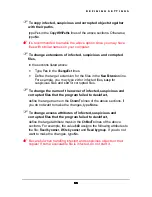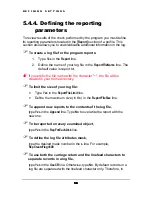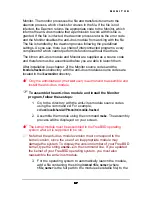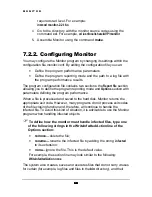
D E F I N I N G S E T T I N G S
53
53
53
53
2. Define the maximum number of simultaneously scanned files
in the
LimitForProcesses
line.
$"
To implement the loop-scanning for viruses:
1. Type
Yes
in the
EndlesslyScan
line. Otherwise, type
No
.
2. Define the interval between two loops (in seconds) in the
ScanDelay
line. For the interval equal to zero type -
1
.
$"
For the program to create temporary files in the memory (but
not on your hard disk):
1. Type
Yes
in the
UseMemoryFiles
line of the
[Tempfiles]
section of
a profile
.
Otherwise type
No.
In this case temporary files will be
created on the hard disk.
2. To limit the size of temporary files to be created in the
memory, define the maximum size (in Kb) in the
LimitForMemFiles
line. The temporary files exceeding this size
will be created on the hard drive.
!"
This setting will be used only if you entered a positive value (
Yes
)
in
the
UseMemoryFiles
line of the
[Tempfiles]
section.
3. To limit the size of files to be extracted in the memory (see
subchapter 5.3.2.5), define the maximum size (in Kb) for this
type of temporary files in the
MemFilesMaxSize
line. In this case
if the file, while being extracted from its archive, will exceed
this value, the program will stop extracting it into the memory
and start generating this temporary file on the hard disk.
!"
This setting will be used only if you entered a positive value (
Yes)
in
the
UseMemoryFiles
line of the
[Tempfiles]
section.
#"
Values in the
LimitForMemFiles
and
MemFilesMaxSize
lines must not
exceed RAM on your computer.
$"
To define the directory for temporary files,
type the path in the
TempPath
line. For example,
TempPath=/tmp
















































